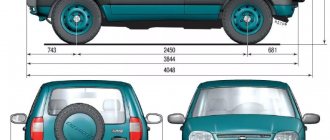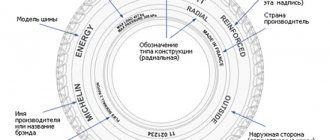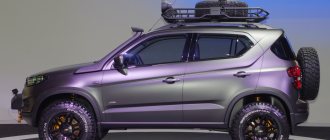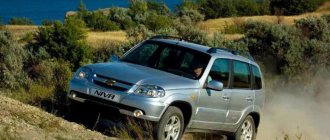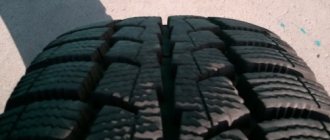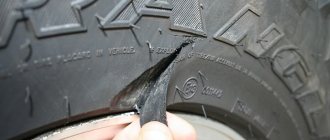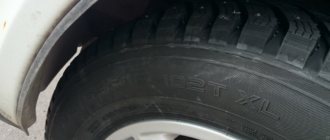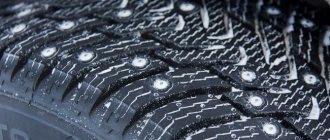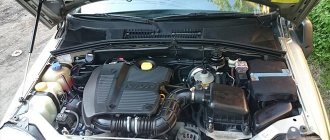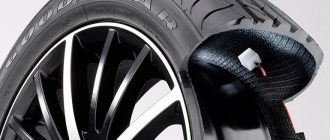When choosing tires for a car, you should remember their intended purpose. Ground clearance, comfort, noise level and cross-country ability depend on a number of parameters.
Size
The main parameter that you should first focus on is the diameter of the corresponding wheel rim. But even the manufacturer itself supplies different modifications with different tires. For example, on the L or LC trim levels, which are considered basic, tires corresponding to 15-inch wheels are installed. The LE comes standard with alloy wheels with a diameter of 16 inches from the factory.
If we talk about the tire width, then for the basic version it is 205 mm, and for the luxury version (GLC and GLS) – 215 mm. The profile height must also be taken into account.
Note that the index means the percentage ratio of the profile height to the tire width.
Chevrolet Niva cars are equipped with low-profile tires (60%) and high-profile tires (70%, 75%). The first is usually used in the city, and the second outside. The disc has its own parameters: offset ET=40 mm, bolt pattern 5x39.5, as well as the diameter of the hub hole, which is 98.5 mm. But these parameters will not be needed to select tires. There is no consensus on the set of parameters. Some owners prefer to use two sets per year, while others make do with all-season tires.
Tread type
The variety of patterns on tires gives a misleading idea about the types of treads. However, there are only three of them.
- A symmetrical tread without direction is characterized by the fact that the tire can be installed on any wheel during installation. This means complete variability in terms of the direction of rotation of the wheel. Such protectors are considered universal, as they are equally suitable for highway and off-road use. As a rule, models with a symmetrical tread are inexpensive and offered by the manufacturer.
- The symmetrical tread with direction removes water from the contact area of the wheel with the road. Such rubber provides reliable grip when driving at high speeds. The direction of rotation of the wheel is indicated by an arrow on the side of the tire.
- The asymmetrical tread is also capable of removing water. But the tire makes no demands on the direction of rotation. It is important to observe the “inside” (inside) and “outside” positions.
Speed index
Rarely does anyone pay attention to this parameter, however, it does not lose its importance because of this. The speed index is indicated by the Latin letters M (130 km/h), N (140 km/h), P (150 km/h), Q (160 km/h), R (170 km/h) and S (180 km/h) h). Considering the speed performance of the Chevrolet Niva, it becomes clear why the speed index is not relevant for owners.
Load Index
The load index refers to the numerical value preceding the speed index. The units are taken arbitrarily and can take a value from 70 to 120. This corresponds to a load of 335 to 1400 kg per wheel, respectively.
So, let's figure out what tires can be installed on the Niva. The standard tire size for the VAZ-2121 is 175/80 R16. Finding replacement narrow and tall tires with a diameter (not to be confused with a radius!) of 16 inches will not be easy. But it's worth a try.
According to reviews from motorists, the basic 16-inch tires for the Niva can be replaced with the following options:
- Hankook Winter Ipike;
- Nokian WRC3;
- Michelin Agilis X-ice North;
- Kama Euro LCV;
- Nokian Hakkapeliita C Cargo;
- Amtel K182A;
- Cordiant Business;
- Continental VanContact.
Many owners of domestic SUVs install R15-sized wheels on their cars. Such a replacement does not require additional modifications or changes. The main advantage is a large selection of tires with a diameter of 15 inches. So, for the Niva you can use the following tire models:
- Yokohama F700Z;
- Amtel NordMaster;
- Toyo Observe Gsi-5;
- Tunga Nordway;
- Gislaved NordFrost 100;
- Cordiant SnowCross;
- Cordiant Off Road;
- Kumho KW 7400;
- Nokian Nordman RS, etc.
Tires, wheels for Chevrolet Niva
Chevrolet Niva has taken a leading position among SUVs on the Russian market. This car is rarely used for its intended purpose, as an off-road vehicle. The Niva is used as an everyday car in urban conditions, excellent for trips out of town and for driving on dirt roads.
What recommendations does KOLOBOX give regarding tire and wheel sizes for Chevrolet Niva?
The size of tires and wheels of a car depends on the year of its manufacture and modification. Chevrolet Niva was released in 2003, today in its only modification.
| Chevrolet Niva; 01/01/2003 | |||||||
| Tires | Discs | ||||||
| R15 | |||||||
| Original | 205/70R15 | Original | 6×15 5*139.7 d98-98.6 ET48 | ||||
| Original | 205/75R15 | Replacement | 6-7×15 5*139.7 d98-111 ET20-48 | ||||
| Replacement | 215/65R15 | ||||||
| Replacement | 215/70R15 | ||||||
| R16 | |||||||
| Original | 215/65R16 | Original | 6.5×16 5*139.7 d98-98.6 ET48 | ||||
| Replacement | 6-8×16 5*139.7 d98-111 ET20-48 | ||||||
| R17 | |||||||
| Replacement | 215/60R17 | Replacement | 6-12×17 5*139.7 d98-111 ET-44-48 | ||||
| Replacement | 235/55R17 | ||||||
The manufacturer installs tires of various sizes depending on the vehicle configuration. Basic configurations are equipped with tires with formulas 205/75R15 and 205/70R15, i.e. Chevrolet Niva L and LC have tires with the following parameters: width 205 mm, profile (width to height ratio) 70 and 75%, radial design, diameter 15 inches.
The Chevrolet Niva LE is equipped with cast wheels made of light metal alloys. The marking of these tires is 215/65R16, i.e. tire width 215, profile 65%, diameter 16 inches, radial design.
The GLS and GLC trim levels are equipped with alloy wheels with tire size 215/65R15. The manufacturing plant positions this size as off-road, although most experienced drivers tend to purchase high-profile wheels for off-road use.
What tires are suitable for a Chevrolet Niva in the winter?
Many drivers refuse to purchase winter tire sets, citing their high cost. The purchase of winter tires is followed by the need to seek tire fitting services (removal of summer tires, installation of new ones, wheel alignment to preserve the tires). There are several reasons why even an SUV needs winter tires:
- A car with all-wheel drive has the same braking performance as a car with single-wheel drive. The only difference is the speed at which the vehicle accelerates.
- Due to not the best aerodynamic characteristics, an all-wheel drive vehicle is less stable in icy conditions.
- SUVs, being heavier than passenger cars, have a greater degree of inertia during braking.
- The misconception of many is that an SUV also exhibits its positive properties in icy conditions, which is a mistake.
How much do mud tires cost on a Chevrolet Niva?
Off-road tires for a Chevrolet Niva may well be inexpensive. But you shouldn’t count on a low price when it comes to extreme wheels. Of course, domestic models are mostly cheaper than foreign ones, but this difference is not always great.
| Tire | Cost per unit, rub. |
| Cordiant Off-Road | 4500-5500 |
| I-569 "Bear" | 3000-5000 |
| Kumho Road Venture | 6000-6500 |
| Federal Couragia M/T | 6700-8700 |
| HANKOOK DYNAPRO MT | 7000-10000 |
| MAXXIS MT-762 | 10000-11000 |
| Cooper Discoverer S/T | 8000-10000 |
| Yokohama Geolandar MT | 5500-7000 |
| Forward Safari 500 | 7000-8000 |
| Simex Extreme Trekker | 11000-13000 |
Photos of the protectors of each model can be found on the sellers’ websites.
Choosing summer tires
Whatever manufacturer you choose, first of all you need to pay attention to the tread pattern.
The expected operating conditions of the car depend on it:
- The manufacturer installs tires with a symmetrical tread pattern without direction; if you wish, you can purchase tires with a directional tread. These wheels are suitable for driving around the city and on the highway.
- For use in more severe conditions, choose tires with an asymmetric tread pattern. A car with such wheels will be controllable on wet asphalt and in moderate off-road conditions.
- If you are going to drive outside the city, it is better to buy special mud tires. Its tread is higher and rarer. Driving on such wheels at high speeds is dangerous, plus they make a lot of noise on the highway.
Also on the rubber there are marks on the load capacity and speed index; these parameters are standard and are suitable for all modern cars. The maximum speed of the Chevrolet Niva is 140 km/h, this value is sufficient for any wheels.
The choice of AT tires is about 29″.
Post by bambr » 07 Apr 2012, 23:05
Dear like-minded people, help me decide. I’m already sitting for the second day trying to choose AT tires in size 235/75/15 for daily use (for extreme trips there is a set of MT tires).
Proposed soils for movement: 60-70% asphalt of varying quality. 20-30% primer (mainly gravel, rocky, sometimes interspersed with clay, with low moisture content). 10% coarse sand (sea). One of the requirements is a strong sidewall. The price of new tires and the subsequent demand for used tires (on the secondary market) with wear of about 40-50% are also taken into account.
After a long selection, 3 candidates remained: 1. GENERAL GRABBER AT2
+ created for sand and rocky terrain, wear resistance close to BFG AT, high quality workmanship. — few reviews, not very good behavior on wet asphalt, prone to aquaplaning (like most AT tires). I couldn't find any information on the strength of the sidewalls.
2. SILVERSTONE AT-117 SPECIAL
+ quite interesting tread pattern, designed for rocky terrain. — there are practically no reviews on the Internet, supposedly less wear-resistant than BGF AT, unstable quality of other (extreme) rubber of this brand, prone to aquaplaning (like most AT rubber).. I couldn’t find information on the strength of the sidewalls.
3. GOODYEAR WRANGLER RADIAL
+ interesting tread pattern, more aggressive lateral lugs, seems not prone to aquaplaning, high quality workmanship - the brand speaks for itself. — there are no reviews on the Internet, it is presented only in some online stores, there is a suspicion that this tire has been discontinued.
Wheel alignment angles "Niva Chevrolet"
The wheel alignment angles on the Chevrolet Niva SUV are as follows:
- The longitudinal inclination angle of the turning axis is 3° 40'+/-30'. This is the angle between the vertical and the projection of the line that passes through the centers of the ball joints onto a plane that is parallel to the longitudinal axis of the machine. It stabilizes the steering of the wheels in the direction of straight-line movement.
- Wheel camber angle - 0° 30'+/-30'. This is the angle between the plane of rotation of the wheel in a straight position and the vertical. It is responsible for the correct position of the rolling wheel during suspension operation.
- The wheel toe value is 0+/-1 mm. This is the angle between the plane of rotation of the wheel and the longitudinal axis of the car.
Wheel alignment angles on Niva Chevrolet
How to choose wheels for a Chevrolet Niva
In order to correctly select the most suitable rims for wheels on the Shniva, you need to know what types of rims are available and how they are made:
- For example, stamped ones , being the cheapest and easiest to produce, are made by stamping from rolled steel. They are easily restored after deformation, but are heavy in weight, which affects the condition of the suspension and worsens the car’s handling. In addition, stamped discs are susceptible to corrosion and bend easily.
- Cast wheels, made from aluminum and other light alloy metals, are not as heavy as steel, have an attractive appearance and do not corrode. But at the same time they are noticeably more expensive and suffer from excessive fragility.
- Forged wheels , being the most expensive, become lighter and stronger than cast wheels through additional mechanical and heat treatment.
The most popular wheels among Chevrolet Niva owners are from the following cars:
- "Suzuki Grand Vitara";
- "Suzuki Jimmy";
- "Kia Sportage";
- "Volga".
Which mud tires are best for a Chevrolet Niva in size?
When selecting suitable mud wheels, even if conversion is planned, Chevrolet owners need to focus on the car parameters that were initially set at the factory. The stock equipment is standard and it is this that determines the possible choice of tire sizes.
The manufacturer equips the car with wheels (alloys are no exception) capable of supporting wheels of a slightly larger diameter than those installed at the factory. And no lifting is required. The standard solution for a crossover is sizes 205/70/R15 or 215/75/R15. Any tire with a 16-inch diameter is suitable, of which there are more than fifteen-inch versions on the market.
Large inch tires easily fit both steel and alloy wheels. In this case, the wheels can reach a height of 26 to 28 inches. Wheels of similar sizes are good for moderate off-road conditions and standard dirt roads in the rural areas of the Middle Zone or the South. And, as noted above, they do not require additional manipulations from the owner in the form of lifting.
Operation in more extreme conditions will require mounting the wheels higher. Most often, tires are installed with a height of up to 29.5 inches, capable of overcoming most types of dirt, but they already require lifting the car. The offset of such wheels reaches 35 millimeters, and as for the diameter, it can equally be either 15 or 16.
Some owners install 31-inch tires. Tires of this height are capable of passing through terrain where there is not even a hint of a path and perform well in the Far North. But the standard size 31/10.5(9.5)/R15 will require a serious reconstruction of the Niva, including not only lifting, but also alteration of the body. As for the diameter of the rims, such extreme wheels are usually installed on the R15.
Radius 15
R15 mud tires are the most common family. Almost all manufacturers of tires for SUVs can boast of models for wheels with this diameter. It is among such modifications that you can find inexpensive foreign models, like HANKOOK DYNAPRO MT and BF Goodrich Mud Terrain. As well as the domestic “bison” I-569 “Bear”. All of them are presented in the most popular sizes 205/75/R15, 205/70/R15 or 215/75/R15.
Radius 16
Unfortunately, the list of mud tire models with a diameter of R16 offered by manufacturers is not that large. The most popular wheels for such rims are, of course, made by the Cordiant brand. But, there are also such high-class foreign tires: Mud Terrain, Kumho Road Venture, Michelin Latitude, Lassa Competus. The last two models belong to the standard size 215 65 p16. You can find out how such tires behave on a Niva Chevy from the video.
Seasonality
According to this criterion, car tires are divided into three types:
Summer
Tires are made of hard rubber that does not soften at high temperatures.
They wear out more slowly on hot asphalt. This guarantees a long service life and short braking distances. The tread pattern of summer tires removes water well from the contact patch and prevents aquaplaning.
However, at low temperatures, the rubber of summer tires loses its elasticity. At temperatures below 5 degrees Celsius, the adhesion coefficient of such tires decreases sharply. In winter, the braking distance of a car with summer tires increases significantly.
Important! Tires that have lost their elasticity glide easily even on clean, dry asphalt. Therefore, it is necessary to install winter tires for the winter.
Winter
The rubber of these tires remains elastic at low temperatures, which ensures reliable grip on asphalt. In order to hold the car on snow or ice, the tread of winter tires has many sipes, the edges of which “cling” to the road.
However, such tires soften greatly on hot asphalt and are not suitable for use in the heat. Separately, it is worth noting the winter studded tires.
They are made of harder rubber than winter non-studded ones. Spikes provide good traction in snow and mud. However, studded tires have a longer braking distance on asphalt and ice. Therefore, in urban conditions it is better to use tires without studs.
All-season
These tires are a cross between summer and winter. Accordingly, they wear out faster than summer tires on hot asphalt. And when used on snow, ice or even winter asphalt, all-season tires do not have a good grip coefficient. Its only advantage in summer is good cross-country ability in mud or sand. Therefore, such tires are not so rare on Niva.
Tires for a Chevy Niva - what parameters should you use to choose it?
In addition to different standard sizes, tires also have a specific purpose that corresponds to their operating conditions.
Winter, summer, all-season
Summer tires are made of hard rubber that does not soften on hot road surfaces. In addition, they are more resistant to wear in high summer temperatures, which provides them with a long service life. The tread pattern of summer tires allows you to successfully remove water from the contact patch and prevent the risk of aquaplaning in puddles. However, summer tires immediately lose all their advantages at low temperatures. Its elasticity disappears, the coefficient of adhesion of tires to the road surface sharply decreases, and the braking distance, on the contrary, increases.
Winter do not have these disadvantages ; they retain their elasticity at low temperatures and thus provide reliable grip on the road surface. In addition, the presence of lamellas on them, which cling to the road surface with their edges, allows the car to be securely held even on ice or snow. However, at high temperatures, winter tires soften greatly and become unsuitable for successful use.
Off-season tires represent a compromise between summer and winter tires. But, having some advantages of both types of tires, all-season tires also have their disadvantages. For example, on a hot road surface it wears out faster than its summer counterpart, and when used on ice, snow or cold asphalt it demonstrates worse road grip than winter tires.
AT and MT
In addition to temperature and weather conditions, the types of tires also take into account the types of road surfaces with which they will have to come into contact. Rubber marked AT is intended for all types of surfaces in an average version. That is, it can be successfully used on the highway, but with noticeably worse performance than conventional road tires. The same thing happens in off-road conditions, where AT tires can also be used, but with less success than specialized tires.
Tires marked MT, judging by the translation from English, are intended specifically “for dirt.” That is, they are specifically aimed at operation in severe off-road conditions, for which they are equipped with a grooved tread with a high tooth profile. Because of them, the car exhibits handling problems on the track. In addition, such tires wear out quickly when used in highway conditions.
Choosing winter tires
Owners believe that there is no need for winter tires on a Chevrolet Niva, since the car is an SUV. The reason why car enthusiasts do not want to install winter tires is simple: high financial costs. Even tires made in Russia, and with the smallest radius possible for a Niva, are expensive. It’s not enough to buy such winter tires; you’ll have to pay for tire fitting services and get an alignment done in order to preserve the product longer. The amount turns out to be quite large. An SUV needs winter tires, and there are a number of reasons for this:
- A four-wheel drive car brakes in exactly the same way as a single-wheel drive car, the only difference is in the acceleration speed.
- On a slippery road, a car with all-wheel drive and increased ground clearance is much less stable, as the aerodynamic characteristics leave much to be desired.
- The SUV performs well off-road, and not in icy conditions.
- Any SUV is quite heavy compared to passenger cars, which means it is more inert. No matter what type of tire is installed, the braking distance will still be longer due to the weight.
The only thing that the Chevrolet Niva can boast of is its high cross-country ability in loose snow. In all other cases, the driver must exercise great caution. This means that you cannot neglect winter tires. For an SUV, this type of tire is no less important than for cars of another class. When choosing winter tires, follow these rules:
- Classic winter tires are the choice of calm and careful drivers.
- You need to choose winter tires according to the climate. If the winter is mild and there is virtually no snow, then it is better to consider all-season tires.
- You cannot change to winter tires on only one axle.
- All tires must be of the same specifications and from the same manufacturer, otherwise handling problems may occur.
- Depending on the driving style, a tread pattern with the corresponding speed index is selected.
If most of the driving in winter is carried out on icy road surfaces, then in this case you cannot do without studs. This option involves a quiet ride, as traction decreases as speed increases.
Top 10 models of winter tires for Niva
It is difficult to find good winter tires for the standard size 185\75\R16, and they are quite expensive. Apart from Amtel, Cordiant and Kama, as well as the Ukrainian Rosava and Belarusian Belshina, by and large, there is nothing else to choose from. Therefore, our top 10 will consist of R15 models.
Among the tires of dimensions 195\70\R15 and 205\70\R15 offered on YandexMarket, we choose those that have a high rating, a large number of positive reviews, as well as those that have an attractive price. These tires will be:
- Gislaved Nord Frost 100 (spikes)
- Nokian Nordman RS (Velcro)
- Hankook Ipike (Velcro)
- Sava Eskimo Ice (Velcro)
- Dunlop Grandtrek Ice 02 (studs)
- Toyo Observe G3-ice (spikes)
- Cordiant SnowCross (studs)
- Yokohama IceGuard IG 30 (Velcro)
- Nokian Hakkapeliitta R (Velcro)
- Yokohama F700Z (spikes)
Which size is better to choose
Large tires are perfectly compatible with standard wheels. An excellent choice without installing a lift would be tires 205 75 15 or 205 70 15 or wheels with a radius of 16, the height of such tires will be 26-28 inches. This type of wheels will perform well both in light off-road conditions and in city conditions.
If you still need to overcome serious obstacles, it is better to install 28-29.5 inch tires on the Chevrolet Niva, but then you will need to lift the SUV.
Standard 16" tire options
The standard tire size for Niva is quite unique - 185\75\R16 - narrow and tall tires of 16 diameter. Not many manufacturers produce tires of this size, and even fewer produce narrow and tall winter tires of 16 diameter.
Since the Niva is primarily an SUV, studded tires are most often selected for it.
Among the most popular are Voltyre VLI-5 and VLI -10. Tires of this particular brand are installed at the factory, so this option is the most inexpensive. But not the most optimal, since the driving characteristics of these tires leave much to be desired.
For standard sizes you can also find winter studded tires of such models as:
- Amtel K182A (Seven Hills)
- Cordiant Business
- Gislaved NordFrost Van
- Nokian Nordman C
- Nokian Hakkapeliita C Cargo
- Michelin Agilis X-ice North
- Good Year Cargo Ultra Grip
Among the options for the standard Niva size you can find tires of the following models:
- KShZ K182A (Amtel Seven Hills)
- Kama Euro LCV
- Rosava LTW
- Viatti Vettore Brina
- Belshina Bravado
- Tigar Cargo Speed
- Yokohama W.Drive
- Hankook Winter Ipike
- Continental VanContact
- Nokian WRC3
However, it is worth mentioning that except for the domestic Amtel, Cordiant and Kama, as well as the Ukrainian Rosava and Belarusian Belshina, all other tires will be quite expensive, so most Niva owners will not consider them as winter tires for their car. Because instead of these expensive 16-radius tires, you can install 15-radius tires, which will cost significantly less.
Recommendations for choosing tires for the Chevrolet Niva
Manufacturer's recommendations
. Depending on the modification of the Chevrolet Niva, R15 or R16 wheels are installed on the factory assembly line. Therefore, before going to a car store, you should find out the equipment of your iron horse. The most common tire sizes are:
Seasonality
. For different times of the year, you should select seasonal “shoes” for the Chevrolet Niva.
- Summer tires behave well in the warm season, allowing the driver to enjoy a fast ride. It is quiet and has good rolling power.
- Winter tires are indispensable when operating a car on snowy or icy roads. Friction models are recommended for the southern regions of the country, and for northern routes it is better to prefer tires with studs.
- For those who like to ride through meadows and forests, special mud tires are recommended. It features an aggressive deep tread that is easy to clean off the ground. The only disadvantage of special tires will be noise on asphalt.
Selecting tire width and profile height
The wider the tire, the:
- the car is more stable on a flat road;
- higher maneuverability;
- Her appearance attracts more attention.
The profile height in Russian stores is indicated as a percentage of the tire width.
If increasing the width by several sizes compared to the manufacturer’s recommendations is problematic due to the body structure, with the height of the profile the limitations are easier to overcome (disc diameter). However, you should adhere to the dimensions suggested by the factory. The value is calculated taking into account the load on the wheels. A significant deviation leads to premature wear of parts, in some cases to an accident.
Within the framework of the profile height values proposed by the plant, regularities should be taken into account. Comfort and braking distance increase with height.
Most consider 205/75 to be the most universal combination of width and height.
Selection of all-season tires
All-season tires differ from others in their tread. The whole secret is that the inner side of such a tire is used for driving on loose snow, and the outer side is used to drain water from the tire contact patch to ensure better traction. When choosing, special attention should be paid to the composition of all-season tires installed on the Chevrolet Niva.
Hard tires are suitable for summer use, reducing wear. The soft one performs better in winter for traveling on snowy and icy roads. Rubber with medium hardness at a medium level will cope with its task at any time of the year. The composition of all-season tires is selected in such a way that they do not harden in cold weather and do not blur in summer. With all this, it is not subject to rapid wear when driving on a dry road and is relatively safe when traveling on snow or ice.
When choosing all-season tires, it’s easy to navigate if you know the main markings on the sides of the rubber:
- Allseasons (AS);
- AnyWeather(AW);
The last two designations are used by manufacturers for summer tires.
According to various tests that are regularly carried out by authoritative publications, the same thing is confirmed every year: a high-quality all-season tire cannot be cheap. All-season tires have a number of significant disadvantages:
- high noise level;
- increased fuel consumption;
- reduction in dynamic characteristics;
- increased wear.
These tires can be used in the following situations:
- mild winter with positive temperatures;
- limited budget;
- there is no space to store two sets of tires;
- desire to save money on tire fitting;
- the off-season, when it’s too early to install a summer one, but it’s a pity to expose the winter one to wear and tear.
Winter tires are always unbeatable on icy roads. All-season tires show the following results: compared to winter ones, they cope with their task worse by 30-40%, studded ones show a better result by 90%. The same disappointing results on loose snow - up to 85% worse.
Those car owners who have ever tried to choose winter tires for a Niva are well aware that the choice is relatively small. The standard sizes of Niva tires with a diameter of 16 inches leave few options for tire brands and models.
To expand the number of options for winter tires suitable for installation, many Niva owners prefer to replace standard wheels with a diameter of 16" with 15" wheels, for example, from the Chevrolet Niva, which fit without any modifications.
From this article you will learn:
The editors of the website "First on Tires" have selected the top 10 best options for winter tires for the Niva.
